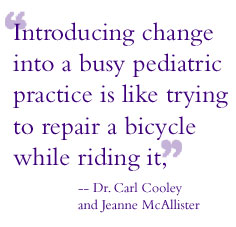
|
For Release: May 20, 2004
Contact: DMS Communications(603) 650-1492
Print Version
Improving Health Care for Children with Special Needs
HANOVER, NH-Health care delivered close to home is vitally important, especially when the patient is a child. But how do community pediatric practices adapt to offer the best care when faced with a child who has complex and often, multiple health needs? Reporting in this month's issue of Pediatrics, Dartmouth researchers outline a process designed to help any practice become a state of the art "medical home" for such children.

Assessing the effectiveness of a model program they developed, Dartmouth Medical School researchers Dr. W. Carl Cooley, adjunct associate professor in pediatrics, and Jeanne McAllister, research associate in pediatrics, review the experience of four practices in Vermont and New Hampshire who used their program to identify and implement changes to improve the care they deliver to children with special health care needs.
The concept of community-based "medical homes" - places where care is managed through coordination of clinicians, educators, therapists, healthcare professionals, and caregivers - has been advocated by national health policy makers and the American Academy of Pediatrics as the best model for providing systematic yet individualized care to children with complex conditions and multiple needs.
Still, the changes required for a practice to become an effective medical home can be difficult to make. "Introducing change into a busy pediatric practice is like trying to repair a bicycle while riding it," the authors write. "Even the most motivated practice finds change difficult to implement. Many primary care providers believe that implementing the medical home concept is the right thing to do but question how they can do so and remain solvent."
To make the process easier, the authors developed a medical home improvement tool kit that allows practices to look at key functions of the medical home, assess their own operation, and identify the steps and strategies they will follow to become a medical home.
The four participating practices all focused on improving different aspects of their medical home environment. In New Hampshire, Exeter Pediatrics Associates of Exeter, developed pre- and post-visit surveys to elicit parents' chief concerns and then assessed whether or not these concerns were addressed in the visit. Dartmouth Hitchcock-Plymouth Pediatrics and Adolescent Medicine of Plymouth created an educational series for children with attention deficit hyperactivity disorder that resulted in new partnerships with parents and schools. In Vermont, Upper Valley Pediatrics of Bradford began to schedule "chronic condition management" visits to provide regular, proactive care rather than only responding to problems after they arose. Gifford Pediatrics of Randolph held a series of community forums aimed at facilitating the exchange of information between families and schools about children with acute care needs. Each project has spurred new improvement projects in related areas.
Each of the participating practices also introduced the role of a practice-based care coordinator and discovered the value of systematic consumer input to the design and operation of the medical home.
The success of the model program in these practices and in practices across the country is encouraging on a number of fronts, according to the authors, who direct The Center for Medical Home Improvement within the Hood Center for Children at the Children's Hospital at Dartmouth-Hitchcock Medical Center. (www.medicalhomeimprovement.org) Establishing medical homes improves access to care, potentially makes more treatments available to children, strengthens the relationship between families and caregivers, and ultimately provides the child with more comprehensive and effective care.
This has significant implications for the health care system nationally, suggest the authors, who note that while children with special health care needs make up only 20 percent of children, they currently account for 80 percent of pediatric health expenses.
The next step for the authors is to investigate the relationship between medical homes and outcomes for children with special needs. They are interested in whether effective medical homes lead to decreased utilization of the health care system, increased patient and family satisfaction, and better health outcomes.
By Thaddeus Shattuck, intern, DMS III
-DMS-